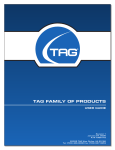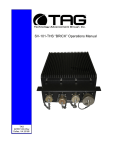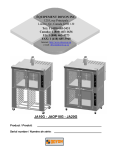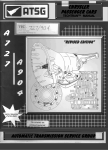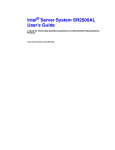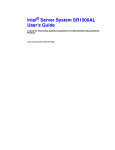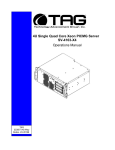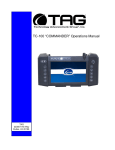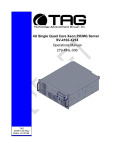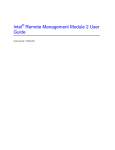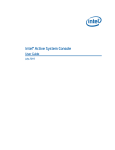Download TAG SV-2003-X2 User's Manual
Transcript
SV-2003-X2 Server Operations Manual TAG 22355 TAG Way Dulles, VA 20166 Operations Manual 1 Copyright © 2008 Technology Advancement Group®, Inc. (TAG®) All rights reserved. This publication and its contents are proprietary to TAG. No part of this publication may be reproduced in any form or by any means without the written permission of TAG, 22355 TAG Way, Dulles, Virginia 20166-9310. TAG has made every effort to ensure the correctness and completeness of the material in this document. TAG shall not be liable for errors contained herein. The information in this document is subject to change without notice. TAG makes no warranty of any kind with regard to this material, including, but not limited to, the implied warranties of merchantability and fitness for a particular purpose. 1.1 Trademarks All trademarks, marks, names, or product names referenced in this publication are the property of respective owners, and TAG neither endorses nor otherwise sponsors any such products or services referred to herein. SV-2003-X2 Server Part Number: 1006446 Page 2 of 72 Version 1.0. 10/30/07 Operations Manual 2 About This Manual 2.1 Scope and Audience This manual provides information on the SV2003-X2 Server. The SV-2003-X2 Server allows for up to 8 cores in a 2U chassis as well as up to 64GB of RAM. Each server features (2) Dual Core LV Xeon processors to maximize processing performance, while reducing power dissipation. Each server is capable of handling (2) Quad-Core Xeon processors. The dual server suite meets military standards such as shock, vibration, and humidity. TAG built the SV-2003-X2 to relieve potential problems with a single failing power supply and to create a product that end users can rely on. The SV-2003-X2 is ideal for transit case and deployable situations where such high density computing minimizes size, weight, and power. 2.1.1 Organization This manual is divided into the following chapters and appendix: • • • • Chapter 1 Cautions and Warnings when handling the SV-2003-X2 Server. Chapter 2 provides detailed information on the external and internal server components. Chapter 3 provides procedures for replacing Hot-Swappable and LRU components, as well as for replacing or adding system memory. Chapter 4 provides a high-level overview that defines RAID, the advantages and disadvantages of various RAID levels, and guidelines to observe when implementing RAID. SV-2003-X2 Server Part Number: 1006446 Page 3 of 72 Version 1.0. 10/30/07 Operations Manual 2.2 About TAG 2.2.1 Summary of Qualifications Providing engineering services and solutions for our national defense and homeland security is a responsibility that we don't take lightly. TAG is a recognized industry leader in developing defense technologies and advanced electronics that support some of the most complex solutions for battlespace information networks and management systems in the world. Our customers depend on our expertise to translate functional requirements and performance objectives into specific design criteria for individual elements and subsystems that comprise larger mission critical systems. For more than twenty years, we have dedicated our experience in engineering to the design of innovative rugged solutions for military and government, and to providing a wide range of enterprise services and Information Assurance in support of the Defense Information Systems Agency's (DISA) Net-Centric initiatives. 2.2.2 Core Competencies TAG designs, manufactures, and supports advanced communications electronics as well as integrates, operates, and supports the users of defense communication and information networks for several technology programs in the United States and abroad. TAG has two operating segments consisting of the Tactical Systems and Information and Engineering Services business units; Tactical Systems provides mechanical, electrical, and thermal engineering for the design and development of MIL-STD certified electronic data enabled systems that are built for in-theater survivability and communication capability over joint enterprise platforms such SV-2003-X2 Server Part Number: 1006446 Page 4 of 72 Version 1.0. 10/30/07 Operations Manual as DSN, GIG, STEP, GBS, and JTRS. This includes the custom ruggedization of commercial-off-the-shelf (COTS) and nondevelopmental items (NDI). TAG's mechanical engineering division designs and fabricates custom hardened enclosures, using high performance metal materials, to house and protect a variety of sensitive devices and controls. TAG's electrical engineering division designs programmable power solutions and advanced sensor technologies including digital receivers, advanced digital signal processors and thermal detection systems. TAG's thermal engineering applies survivability techniques to ensure systems and instruments are designed to withstand harsh environmental conditions encountered by land-based, airborne, and shipboard system in operations Information and Engineering Services provides a wide range of customer support operations, enterprise network and communications engineering services combining the experience and expertise required to achieve network and communication interoperability for component hardware and software elements. This includes design, simulation, analysis, and testing of the components or systems for the support of command and control operations. Our team of national security cleared network engineering professionals provides planning support for information systems, architectures, and networks while developing strategies that lay the groundwork for sound technical foundations for programmatic plans. Our expertise in analyzing, designing, implementing, and managing network, telecommunication and security solutions addresses the full lifecycle approach to providing mission oriented enterprise class services. SV-2003-X2 Server Part Number: 1006446 Page 5 of 72 Version 1.0. 10/30/07 Operations Manual Document Revision History Date 02/14/2008 03/20/2008 Version Number 1.0 1.1 Updated By Alan Huckerby Alan Huckerby Description of Changes Author Author SV-2003-X2 Server Part Number: 1006446 Page 6 of 72 Version 1.0. 10/30/07 Operations Manual Table of Contents Contents 1 Copyright © 2008 Technology Advancement Group®, Inc. (TAG®) ............................ 2 1.1 Trademarks ............................................................................................................ 2 2 About This Manual ....................................................................................................... 3 2.1 Scope and Audience .............................................................................................. 3 2.1.1 Organization ...................................................................................................... 3 2.2 About TAG .............................................................................................................. 4 2.2.1 Summary of Qualifications ................................................................................ 4 2.2.2 Core Competencies .......................................................................................... 4 3 Safety Instructions ....................................................................................................... 12 3.1 Types of warnings used in this manual ................................................................... 12 3.1.1 Safety Symbols and Labels ............................................................................... 12 3.1.2 Conventions ...................................................................................................... 12 4 Server Overview .......................................................................................................... 15 4.1 Product Information ................................................................................................ 15 4.2 SV-2003-X2 Server ................................................................................................ 15 4.2.1 Specifications .................................................................................................... 15 4.2.2 Additional Specifications ................................................................................... 16 4.2.3 Server Highlights ............................................................................................... 17 4.2.4 SV-2003-X2 Server ........................................................................................... 17 4.3 Server Components ................................................................................................ 17 4.3.1 Motherboard and Type ..................................................................................... 18 4.3.2 SV-2003-X2 Server Motherboard ...................................................................... 18 4.3.3 Connector and Component Locations ............................................................... 19 4.4 System Memory...................................................................................................... 20 4.4.1 Identifying System Memory ............................................................................... 20 4.5 TAG Approved BIOS .............................................................................................. 21 4.5.1 Common BIOS Settings .................................................................................... 21 4.6 Identifying your I/O Connectors .............................................................................. 24 4.7 Standard Server Components ................................................................................ 25 4.7.1 CD/DVD Drive ................................................................................................... 25 4.7.2 Dual-redundant, auto-sensing power supply ..................................................... 26 4.8 PCI I/O Expansion Cards ....................................................................................... 27 4.8.1 Adaptec PCI-Express RAID Controller .............................................................. 27 4.8.2 PCI Audio Card ................................................................................................. 28 4.8.3 Intel Remote Management Module ................................................................... 28 5 Procedures .................................................................................................................. 31 5.1 Installing Red Hat 4.5 for S5000PAL and Adaptec 3805 system ............................ 31 5.2 Server Startup ........................................................................................................ 50 5.3 Server Shutdown .................................................................................................... 50 5.3.1 BIOS Configuration for SV-2003-X3 .................................................................. 51 SV-2003-X2 Server Part Number: 1006446 Page 7 of 72 Version 1.0. 10/30/07 Operations Manual 5.4 Upgrading Memory and Replacing Hot-Swap and LRU Components .................... 58 5.4.1 Preventing Static Electricity ............................................................................... 58 5.5 Replacing a Hot-Swap Power Supply Module ........................................................ 59 5.6 Replacing a Hot-Swap Hard Drive .......................................................................... 60 5.6.1 147GB SAS Hard Drive ..................................................................................... 61 5.7 Removing the Server Cover ................................................................................... 61 5.8 Adding or Replacing System Memory .................................................................... 62 5.8.1 Install system memory. ..................................................................................... 63 6 RAID ............................................................................................................................ 65 6.1 RAID Defined.......................................................................................................... 65 6.1.1 Reasons for RAID ............................................................................................. 66 6.1.2 RAID Level 0 ..................................................................................................... 66 6.1.3 RAID Level 1 ..................................................................................................... 66 6.2 Configuring RAID 1 ON ADAPTEC 3805 ............................................................... 68 6.2.1 72 SV-2003-X2 Server Part Number: 1006446 Page 8 of 72 Version 1.0. 10/30/07 Operations Manual List of Figures Figure 4-1 SV-2003-X2 Server Components and Connectors (Front View) ................. 17 Figure 4-2 Server Mother Board .................................................................................... 18 Figure 4-3 Server Mother Board .................................................................................... 19 Figure 4-4 I/O Connectors ............................................................................................. 25 Figure 4-5 Slot-loading low-profile DVD±R (DL)/-RAM/CD-RW Drive ........................... 25 Figure 4-6 Hot-Swap Power Supply .............................................................................. 27 Figure 5-1 Confirm Boot order ....................................................................................... 31 Figure 5-2 Introductory Screen ...................................................................................... 32 Figure 5-3 Loading Drivers ............................................................................................ 32 Figure 5-4 Welcome Screen .......................................................................................... 33 Figure 5-5 Language Screen ......................................................................................... 33 Figure 5-6 Keyboard Selection ...................................................................................... 34 Figure 5-7 Search for previously installed installations.................................................. 34 Figure 5-8 Disk Partitioning Setup ................................................................................. 35 Figure 5-9 Disk Partition Warning ................................................................................. 35 Figure 5-10 Automatic partitioning ................................................................................ 36 Figure 5-11 Automatic Partitioning (Warning) ............................................................... 36 Figure 5-12 Disk Setup.................................................................................................. 37 Figure 5-13 Boot Loader Configuration ......................................................................... 37 Figure 5-14 Firewall Configuration ................................................................................ 38 Figure 5-15 Additional Language Support ..................................................................... 38 Figure 5-16 Time Zone Selection .................................................................................. 39 Figure 5-17 Set Root Password .................................................................................... 39 Figure 5-18 Set Root Password (Confirmation) ............................................................. 40 Figure 5-19 Package Installation Defaults ..................................................................... 40 Figure 5-20 About to Install ........................................................................................... 41 Figure 5-21 Installation .................................................................................................. 41 Figure 5-22 Still Installing Buttons are disabled. ........................................................... 42 Figure 5-23 Installation Complete ................................................................................. 42 Figure 5-24 System Check ............................................................................................ 43 Figure 5-25 Welcome .................................................................................................... 43 Figure 5-26 License Agreement .................................................................................... 44 Figure 5-27 Set Date and Time ..................................................................................... 44 Figure 5-28 Set Display Color and Resolution. ............................................................. 45 Figure 5-29 Set Color Depth ......................................................................................... 45 Figure 5-30 Display ....................................................................................................... 46 Figure 5-31 System User (Non Administrative) ............................................................. 46 Figure 5-32 Personal user Account ............................................................................... 47 Figure 5-33 Additional CDs ........................................................................................... 47 Figure 5-34 Finish Setup ............................................................................................... 48 Figure 5-35 Log In Screen............................................................................................. 48 Figure 5-36 Log in Screen ............................................................................................. 49 Figure 5-37 BIOS Setup ................................................................................................ 51 SV-2003-X2 Server Part Number: 1006446 Page 9 of 72 Version 1.0. 10/30/07 Operations Manual Figure 5-38 Processor Configuration............................................................................. 51 Figure 5-39 Processor Configuration............................................................................. 52 Figure 5-40 Memory Configuration ................................................................................ 52 Figure 5-41 ATA Controller Configuration ..................................................................... 53 Figure 5-42 Serial Port Configuration ............................................................................ 53 Figure 5-43 Floppy/USB Configuration.......................................................................... 54 Figure 5-44 PCI Configuration ....................................................................................... 54 Figure 5-45 System Acoustic Configuration .................................................................. 55 Figure 5-46 Security ...................................................................................................... 55 Figure 5-47 Server Management .................................................................................. 56 Figure 5-48 Boot Order. ................................................................................................ 56 Figure 5-49 Save Changes ........................................................................................... 57 Figure 5-50 Grounding Wrist Strap ............................................................................... 58 Figure 5-51 Hot-Swap of 2U Server Power Supply Module .......................................... 60 Figure 5-52 147GB SAS HDD (Removed from HD Carrier) .......................................... 61 Figure 5-53 DIMM Module Bank ................................................................................... 63 Figure 6-1 RAID Level 1 (Mirroring) .............................................................................. 67 Figure 6-2 Raid Setup Utility ......................................................................................... 68 Figure 6-3 Array Configuration Utility ............................................................................ 68 Figure 6-4 Create Array................................................................................................. 69 Figure 6-5 Select Both Drives ....................................................................................... 69 Figure 6-6 Highlight RAID ............................................................................................. 70 Figure 6-7 Array Properties ........................................................................................... 70 Figure 6-8 Array Properties ........................................................................................... 71 List of Tables Table 4-1 Mother Server Board Components ................................................................ 20 SV-2003-X2 Server Part Number: 1006446 Page 10 of 72 Version 1.0. 10/30/07 Operations Manual Chapter 1 Cautions and Warnings. Electronically distributed. Subject to user discretion when printed. SV-2003-X2 Server Part Number: 1006446 Page 11 of 72 Version 1.0. 10/30/07 Operations Manual 3 Safety Instructions 3.1 Types of warnings used in this manual Read this manual thoroughly, paying special attention to the cautions and warnings. 3.1.1 Safety Symbols and Labels DANGER WARNING CAUTION These warnings and cautions indicate situations or practice that might result in property damage. 3.1.2 Conventions 3.1.2.1 Important Messages Important messages appear where mishandling of components is possible or when work orders can be misunderstood. These messages also provide vital information associated with other aspects of system operation. The word “important” is written as “IMPORTANT,” both capitalized and bold and is followed by text in italics. The italicized text is the important message. 3.1.2.2 Warnings Warnings appear where overlooked details may cause damage to the equipment or result in personal injury. Warnings should be taken seriously. Warnings are easy to recognize. The word “warning” is written as “WARNING,” both capitalized and bold and is followed by text in italics. The italicized text is the warning message. SV-2003-X2 Server Part Number: 1006446 Page 12 of 72 Version 1.0. 10/30/07 Operations Manual 3.1.2.3 Cautions Cautionary messages should also be heeded to help you reduce the chance of losing data or damaging the system. Cautions are easy to recognize. The word “caution” is written as “CAUTION,” both capitalized and bold and is followed by text in italics. The italicized text is the cautionary message. 3.1.2.4 Notes Notes inform the reader of essential but noncritical information. These messages should be read carefully as any directions or instructions contained therein can help you avoid making mistakes. Notes are easy to recognize. The word “note” is written as “NOTE,” SV-2003-X2 Server Part Number: 1006446 Page 13 of 72 Version 1.0. 10/30/07 Operations Manual Chapter 2 SV-2003-X2 Server. Electronically distributed. Subject to user discretion when printed. SV-2003-X2 Server Part Number: 1006446 Page 14 of 72 Version 1.0. 10/30/07 Operations Manual 4 Server Overview 4.1 Product Information This chapter provides an introductory overview of the TAG family of rugged servers. TAG servers are highly customizable; the specific components vary depending on the mission requirements. Your system may contain components not described in this chapter. For detailed information on these components, refer to the manufactures website or contact TAG Technical Support at [email protected]. TAG's rugged servers combine Intel® technology with state-of-the-art mechanical, thermal and electrical engineering to create customized systems that perform above and beyond end user or program specifications. Our rugged servers are designed to meet and exceed many MIL-STD requirements to ensure survivability in the field. 4.2 SV-2003-X2 Server 4.2.1 Specifications Chassis & power supply: • 2U Heavy-duty, .090inch Aluminum/Magnesium alloy, strain hardened and stabilized rack-mount chassis • Chassis is designed to EIA-310-D Standards • 3.5”H x 19”W x 24”D • Redundant, Hot-Swap, auto-sensing power supplies • Cooling system developed specifically for harsh environments • Front accessible on/off switches • Intelligent Fan Controller Acoustically optimized, environmentally aware • Processor & Cache: (2) Dual Core Intel Xeon 5138 CPU’s Motherboard and On-board Features: SV-2003-X2 Server Part Number: 1006446 Page 15 of 72 Version 1.0. 10/30/07 Operations Manual • • • • • • • • Intel 5000P chipset, 1333MHz FSB On-board ATI graphics controller with 16MB RAM On-board SATA controllers (2) 10/100/1000 Ethernet ports One serial port (RJ-45 connection (2) USB 2.0 ports front, (2) USB 2.0 ports rear PS/2 Keyboard & Mouse port Expandable to 32GB FBDIMM System Components: 8GB FB DIMM (2) 400GB Hot-Swap, removable SAS hard drives with rugged metal carriers and receivers • (2) Additional hard drive expansion bays • PCI Audio card • Intel remote server management module • Low-profile DVD±RW(DL),-RAM,CD-RW drive • PCI Express SAS RAID controller (Support for RAID 0,1, and 5) 4.2.2 Additional Specifications • Total Weight: 42lbs • Input Voltage Range: 115 Vrms nominal, 98 to 138 Vrms (-15%, +20%) • Input Frequency Range: 60 Hz nominal, 56.4 to 63.6 Hz (- 6%, + 6%) • Maximum Operating Power: 494.4 Watts • Maximum Operating Current: 4.12 Amps • Typical Operating Power: 410.4 Watts • Typical Operating Current: 3.42 Amps • Idle Power: 367 Watts • Idle Current: 3.059 Amps • AC Input Power Connector: IEC 320 • PFC: .97 Typical • Operating Temp Range: 0-50°C • Non-Operating Temp range: -40-70°C • Operating Humidity: up to 90% noncondensing • Shock: Designed to meet MIL-STD-901D Grade B • Vibration: Designed to meet MIL-STD-167-1 • • SV-2003-X2 Server Part Number: 1006446 Page 16 of 72 Version 1.0. 10/30/07 Operations Manual 4.2.3 Server Highlights • The SV-2003-X2 is unlike any other server that is currently on the market. The SV-2003-X2 is ideal for use in deployable situations where the product’s compact size, high density computing, minimized size, weight, and power make for a highly portable, rugged and reliable system • Designed to meet MIL-STD-901D, MIL-STD810F, MIL-STD-167, MIL-STD-461E, and MILSTD-740 • Contains an intelligent fan controller (acoustically optimized, environmentally aware) • The chassis is made of environmentally protected 5052 aluminum-alloy strain hardened and stabilized chassis • Proven to function in extreme operating temperature ranges 4.2.4 SV-2003-X2 Server Figure 4-1 SV-2003-X2 Server Components and Connectors (Front View) 4.3 Server Components This section provides an overview of the most common components installed in TAG rugged servers. Information is also provided on how to identify specific components within your server. For detailed information on the specific components installed in your server, refer the manufactures website. SV-2003-X2 Server Part Number: 1006446 Page 17 of 72 Version 1.0. 10/30/07 Operations Manual 4.3.1 Motherboard and Type The version of an Intel server motherboard can be determined by decoding the last three digits of the board part number. For example: For the product C44686-703, the number following the "-" is as follows: 7 = Fabrication (FAB) Number 03 = Revision 3. The board part number can be found on the motherboard. The board part number can also be determined by using Intel Server Management software. 4.3.2 SV-2003-X2 Server Motherboard Figure 4-2 shows the primary components of the motherboard. Figure 4-2 Server Mother Board SV-2003-X2 Server Part Number: 1006446 Page 18 of 72 Version 1.0. 10/30/07 Operations Manual 4.3.3 Connector and Component Locations Figure 4.3 shows the board layout of the server board. Each connector and major component is identified by a number or letter, and a description is given below in Table 4.3. Figure 4-3 Server Mother Board SV-2003-X2 Server Part Number: 1006446 Page 19 of 72 Version 1.0. 10/30/07 Operations Manual Table 4-1 Mother Server Board Components 4.4 System Memory The type and amount of system memory, or RAM (random access memory), on your server depends on the motherboard installed and how it was configured. 4.4.1 Identifying System Memory Refer to your Motherboard and Type on Page 19.” Once you have identified the motherboard, TAG technical support can assist you in determining the type and amount of system memory in your system. See “Contacting information on TAG on back page of this manual for information on how to contact Technical Support. SV-2003-X2 Server Part Number: 1006446 Page 20 of 72 Version 1.0. 10/30/07 Operations Manual For information on replacing or upgrading your system memory, refer to “Adding and Replacing System Memory on page 58.” 4.5 TAG Approved BIOS The BIOS (basic input/output system) is the program stored on the CMOS that the server's microprocessor uses to get the system started after you turn it on. The BIOS also manages data flow between the computer's operating system and attached devices such as the hard disk, video adapter, keyboard, and mouse. CAUTION: The BIOS installed on your server was loaded and tested with all the devices initially installed in your system. If you desire to have the BIOS updated, consult TAG technical support in advance as updates to your approved BIOS may cause your system to become unstable or inoperable. 4.5.1 Common BIOS Settings Printer Parallel Port-Uni., Bi-directional, Disable, Enable, ECP, EPP 4.5.1.1 Printer Parallel Port Uni., Bi-Directional, Disable, Enable, ECP, EPP. Settings in the CMOS enable you to configure a parallel port to use Enhanced Parallel Port (EPP) or Enhanced Parallel Port (ECP). ECP. EPP and ECP are bi-directional standards, operate in 8-bit, and allow data transfer speed of approximately 2 MB/s. Some of the main differences are that ECP supports Direct Memory Access (DMA) and data compression, which enables higher transfer rates. It is also possible to completely disable the parallel port in the BIOS. Most BIOS' allow you to set the DMA channel, when the port mode is set to ECP. SV-2003-X2 Server Part Number: 1006446 Page 21 of 72 Version 1.0. 10/30/07 Operations Manual 4.5.1.2 Com / Serial Port Most personal computers have two serial ports. In the BIOS you can assign COM1/COM2/COM3/COM4 to serial port 1 or 2. Most BIOS' also allow you to set the I/O and IRQ but this is mostly done automatically. 4.5.1.3 Hard Drives Most modern BIOS' allow automatic detection of disk parameters. The settings can be individually configured for the primary master and slave device and the secondary master and slave device. The following are some of the primary settings that apply to hard drives as well as CD/DVD-ROM drives, tape backup drive, etc. • • • • • • • • • • Common disk types are: User-defined Cylinders, Heads, Sectors (CHS) values Auto-automatically detects hard disks parameters at every startup 1-46-predefined combinations of CHS values CDROM-used for AT Attachment Packet Interface (ATAPI) CD-ROM drives ARMD-used for ATAPI ZIP and LS 120 drives DVDROM Size - Determines the capacity of the drive CHS values Number of Cylinders Number of Heads Number of Sectors LBA (Large Block Addressing)-technology to overcome the 528 MB limit SV-2003-X2 Server Part Number: 1006446 Page 22 of 72 Version 1.0. 10/30/07 Operations Manual 4.5.1.4 Boot Sector Virus A common setting related to hard drives. When enabled, the BIOS issues a warning message/beep if an attempt is made to write to the boot sector or partition table of a hard disk. 4.5.1.5 Memory Parity adds an extra bit (odd or even) to the 8bit data-string to ensure data integrity in memory modules. Its successor, ECC, provides improved data integrity by adding information about individual bits. 4.5.1.6 Boot Sequence This setting is used to control the order that the BIOS uses during the boot process to look for a boot device from which to load the operating system. For example: • • • CD Floppy Hard Disk 4.5.1.7 Date and Time The Date and Time is set in the BIOS, stored in CMOS, and maintained by CMOS battery. 4.5.1.8 Passwords In most cases a user (startup) password and a supervisor (setup) password can be set in the CMOS. When a Setup password is required, the computer will prompt for it when you try to access the BIOS setup. When a Startup password is configured, the computer will prompt for it at every startup. The CMOS password can be reset by shortening the "CMOS restore to factory defaults jumper" or by temporarily removing the CMOS battery. SV-2003-X2 Server Part Number: 1006446 Page 23 of 72 Version 1.0. 10/30/07 Operations Manual 4.5.1.9 Plug and Play BIOS Today's BIOS' are Plug and Play (PnP)-aware. This means they are able to automatically assign resources such as IRQ and DMA to PnP devices. Information about PnP devices is stored in a separate area of non-volatile CMOS memory, called the Extended System Configuration Database (ESCD). Both the PnP BIOS and the operating system can access this area and communicate with each other about resource settings assigned to PnP devices as well as non-PnP devices. For example, when a fixed interrupt request (IRQ) is manually assigned to a particular device using Device Manager, Windows will write this information to the ESCD on shutdown thereby preventing the BIOS from assigning the same IRQ to a PnP device at startup. You can also reserve IRQs for non-PnP devices in the CMOS setup, this will prevent the BIOS from assigning these reserved resources to PnP devices, a common example is a legacy sound card that needs IRQ 5. 4.5.1.10 Power Management Modern motherboards provide Advanced Configuration and Power Management Interface (ACPI) settings such as wake-up, power button function and standby/suspend timers. These functions are configured in the CMOS Setup. 4.6 Identifying your I/O Connectors Figure4-4 shows a typical configuration of I/O connectors. Your configuration may vary depending on the motherboard installed in your server. SV-2003-X2 Server Part Number: 1006446 Page 24 of 72 Version 1.0. 10/30/07 Operations Manual Figure 4-4 I/O Connectors 4.7 Standard Server Components The following sections provide information on the standard system components installed on TAG servers 4.7.1 CD/DVD Drive The type of optical drive installed in your server varies per configuration. Figure 4.5. Figure 4-5 Slot-loading low-profile DVD±R (DL)/-RAM/CD-RW Drive SV-2003-X2 Server Part Number: 1006446 Page 25 of 72 Version 1.0. 10/30/07 Operations Manual 4.7.2 Dual-redundant, auto-sensing power supply Power for all the equipment in the system is a dual redundant Hot-Swap AC input Power supply with an Input AC Voltage Range of 115 Vrms nominal, 98 to 138 Vrms (-15%, +20%). Input Power Line Frequency The system shall operate over the input power frequency range of 60 Hz nominal, 56.4 to 63.6 Hz (- 6%, + 6%). Power Connector The AC input power connector is IEC 320 WARNING Power supplies contain dangerous voltages. Before attempting to work on any power supply always unplug the device and drain the power source by turning the server on after the power supply has been disconnected. Failure to follow these instructions could result in serious injury due to electrical shock. To satisfy reliability requirements, TAG servers are designed with Hot-Swappable power supplies. If in the event of a power supply module failure or if the power source fails and only one module is receiving power, an audible alarm sounds. For procedures on how to HotSwap a power supply module refer to the Procedures Section of this manual. Replacing a Hot-Swap power supply. Although most TAG power supplies for the 1U and 4U series servers are similar in physical sizes, and physical characteristics, some servers use smaller foot print power supplies. Figure 4-11 shows a typical 4U Hot-Swap power supply. SV-2003-X2 Server Part Number: 1006446 Page 26 of 72 Version 1.0. 10/30/07 Operations Manual Figure 4-6 Hot-Swap Power Supply NOTE: If your server has two power input receptacles, then the server is equipped with a redundant Hot-Swap power supply. Section 5.8. 4.8 PCI I/O Expansion Cards The following sections provide on overview of the PCI I/O components that may be included with your server. For detailed information on these components, refer to the manufacturers' websites, or contact TAG Technical Support at [email protected]. For more information, See back page of this document. 4.8.1 Adaptec PCI-Express RAID Controller The Adaptec RAID 3805 is an 8-port controller that supports SATA and SAS drives. It features Adaptec RAID Code (ARC) with RAID levels 0, 1, 1E, 5, 5EE, 6, 10, 50, 60, JBOD, as well as Copy back Hot Spare and optional Snapshot Backup. The card has 128MB of DDR2 memory. SV-2003-X2 Server Part Number: 1006446 Page 27 of 72 Version 1.0. 10/30/07 Operations Manual 4.8.2 PCI Audio Card The SV-2003-X2 server carries a PCI Sound Blaster 24 –bit Audio card with: • Patented CMSS 3D Audio Technology • EAX Music Enhancements • Full Windows Media Player 9 Support • Complete Cinematic Surround Sound 4.8.3 Intel Remote Management Module The Intel RMM2 is used for the initial server set-up, on-going production monitoring and troubleshooting, and for server recovery and maintenance. Features • Embedded Web Server Connects administrators to remote servers over a secured connection to monitor system health and perform a variety of maintenance tasks with a supported web browser • Soft Keyboard via KVM Multiple language support • Customized Branding Promotes OEM brand through selection of icons, colors, and logos on user interface • Remote KVM provides full keyboard, mouse, and video access to the server over the LAN • Virtual Media Redirection allows remote OS and/or software installation and maintenance to access locally attached devices such as floppy drives, CD-ROM drives, hard disks, and USB Flash devices • Dedicated Network Segments manages traffic onto dedicated networks for administrative and bandwidth optimization • Interface Card SV-2003-X2 Server Part Number: 1006446 Page 28 of 72 Version 1.0. 10/30/07 Operations Manual • Security SSL, SSH, KVM Encryption, authentication using LDAP or RADIUS • Remote Management, power control or reset remote servers, monitor system sensors, and view the hardware event log • SMASH CLP, WS-MAN • Email Alert sends system administrators notifications via email of system changes . SV-2003-X2 Server Part Number: 1006446 Page 29 of 72 Version 1.0. 10/30/07 Chapter 3 Chapter 3 Procedures. Electronically distributed. Subject to user discretion when printed. SV-2003-X2 Server Part Number: 1006446 Page 30 of 72 Version 1.0. 10/30/07 Chapter 3 5 Procedures The procedures within this Chapter contain relevant information to ensure your SV-2003X2 Server maintains its maximum performance potential. 5.1 Installing Red Hat 4.5 for S5000PAL and Adaptec 3805 system 1. Make sure that the supplied floppy is in a USB floppy drive and attached to the system; be sure the DVD is in the DVD-ROM. 2. With the hard drives set in RAID, enter BIOS and confirm the boot order: [IDE PM: MATSHITACD...], [AAR-3805 PCI-E RAI...], [IBA GE Slot 0500 v...], [Y-E DATAUSB-FDU ...], [[EFI Shell]]. (Figure 5.1) Figure 5-1 Confirm Boot order 3. Once the computer boots to the Red Hat Enterprise Linux 4.5 main screen (Figure 5.2), type the following command as written: Press Enter. SV-2003-X2 Server Part Number: 1006446 Page 31 of 72 Version 1.0. 10/30/07 Chapter 3 This will trigger the automated format and install onto the RAID. After the install is complete the DVD will eject and boot into the Linux OS. Figure 5-2 Introductory Screen 4. Press Enter Figure 5-3 Loading Drivers SV-2003-X2 Server Part Number: 1006446 Page 32 of 72 Version 1.0. 10/30/07 Chapter 3 After the drivers have been installed you will see the full welcoming screen that will allow you to install the full version of Linux 4.5. Figure 5-4 Welcome Screen 5. Press Next. This will take you to the language screen. Figure 5-5 Language Screen SV-2003-X2 Server Part Number: 1006446 Page 33 of 72 Version 1.0. 10/30/07 Chapter 3 6. At the language screen select English (English) and Press Next. Figure 5-6 Keyboard Selection 7. Select the appropriate keyboard selection and press Next. Figure 5-7 Search for previously installed installations SV-2003-X2 Server Part Number: 1006446 Page 34 of 72 Version 1.0. 10/30/07 Chapter 3 8. At the keyboard screen and after keyboard is chosen the system will automatically search for previously installed configurations. Press Next. Figure 5-8 Disk Partitioning Setup 9. Select Automatic Partitioning and Press Next. Figure 5-9 Disk Partition Warning SV-2003-X2 Server Part Number: 1006446 Page 35 of 72 Version 1.0. 10/30/07 Chapter 3 10. At the Disk Partitioning Warning Select YES and Press Next. Figure 5-10 Automatic partitioning At the Automatic partitioning screen Select “Remove all Partitions on this system.” Ensure that both driver sda-139784 MB ADAPTEC RAID stripe and Review (and modify if needed) the partitions created are checked. Press Next. Figure 5-11 Automatic Partitioning (Warning) SV-2003-X2 Server Part Number: 1006446 Page 36 of 72 Version 1.0. 10/30/07 Chapter 3 11. At the Automatic Partitioning screen a further warning will appear. Select YES and Press Next. Figure 5-12 Disk Setup 12. Leave the settings on default and Press Next. Figure 5-13 Boot Loader Configuration SV-2003-X2 Server Part Number: 1006446 Page 37 of 72 Version 1.0. 10/30/07 Chapter 3 13. Leave the settings on default and Press Next Figure 5-14 Firewall Configuration 14. Check “Enable Fire Wall” Press Next. Figure 5-15 Additional Language Support 15. At the “Additional Language Support” screen Check English (USA). Press Next. SV-2003-X2 Server Part Number: 1006446 Page 38 of 72 Version 1.0. 10/30/07 Chapter 3 Figure 5-16 Time Zone Selection 16. At the “Time Zone Selection” screen Select America/New York, Eastern Time. Press Next. Figure 5-17 Set Root Password SV-2003-X2 Server Part Number: 1006446 Page 39 of 72 Version 1.0. 10/30/07 Chapter 3 17. Enter and confirm account password. Must enter Password as “Password” selection. Press Next. Figure 5-18 Set Root Password (Confirmation) 18. Confirm Root User password selection. Press Next. Figure 5-19 Package Installation Defaults SV-2003-X2 Server Part Number: 1006446 Page 40 of 72 Version 1.0. 10/30/07 Chapter 3 19. On the “Package Installation Default” screen Select “Install Default Software Packages”. Press Next. Figure 5-20 About to Install CAUTION: Once you click Next there is no undo. 20. Press NEXT to begin installation. Figure 5-21 Installation SV-2003-X2 Server Part Number: 1006446 Page 41 of 72 Version 1.0. 10/30/07 Chapter 3 21. Press Next Figure 5-22 Still Installing Buttons are disabled. Figure 5-23 Installation Complete 22. Remove all diskettes or CD ROMs. Press REBOOT. 23. SV-2003-X2 Server Part Number: 1006446 Page 42 of 72 Version 1.0. 10/30/07 Chapter 3 Figure 5-24 System Check Figure 5-25 Welcome 24. Press Next. SV-2003-X2 Server Part Number: 1006446 Page 43 of 72 Version 1.0. 10/30/07 Chapter 3 Figure 5-26 License Agreement Check YES If you agree to the licensing agreement. Press Next. Figure 5-27 Set Date and Time 25. Set Date and Time for the system. Press Next. SV-2003-X2 Server Part Number: 1006446 Page 44 of 72 Version 1.0. 10/30/07 Chapter 3 Figure 5-28 Set Display Color and Resolution. 26. Press Next. Figure 5-29 Set Color Depth 27. Change the Resolution to “1024 x 768” (Your displays optional resolution. Default is 1024 x 768.). Press Next. SV-2003-X2 Server Part Number: 1006446 Page 45 of 72 Version 1.0. 10/30/07 Chapter 3 Figure 5-30 Display 28. Select Color display and Resolution. Press Next. Figure 5-31 System User (Non Administrative) 29. Press Next. SV-2003-X2 Server Part Number: 1006446 Page 46 of 72 Version 1.0. 10/30/07 Chapter 3 Figure 5-32 Personal user Account 30. Create a Personal User Account. Click Continue and Press Next. Figure 5-33 Additional CDs 31. Installation as required. Press Next. SV-2003-X2 Server Part Number: 1006446 Page 47 of 72 Version 1.0. 10/30/07 Chapter 3 Figure 5-34 Finish Setup 32. Press Next Figure 5-35 Log In Screen 33. Enter User name. SV-2003-X2 Server Part Number: 1006446 Page 48 of 72 Version 1.0. 10/30/07 Chapter 3 Figure 5-36 Log in Screen 34. Enter Password. Installation Complete. SV-2003-X2 Server Part Number: 1006446 Page 49 of 72 Version 1.0. 10/30/07 Chapter 3 5.2 Server Startup 1. Check to make sure that all the cables are seated and connected correctly to the back of the unit such as keyboard, mouse, monitor VGA cable and both power cables. 2. Then Press the power switch ON to start the computer (power switch is located in the front of the unit) 3. Once the unit starts, System will go thru Power On self Test (POST) (no action is required at this time) 4. At windows dialog box press Ctrl, Alt, Delete at once to login 5. Type in the correct user name and password and then press enter to login 6. Once the operator is logged on to the unit they could use the computer as they wish. NOTE: Assuming the server is not connected to any network. 5.3 Server Shutdown 1. The operator needs save any data that is needed to be saved and then close application 2. Once all data is save and applications are closed, click on Start menu, select shutdown and then click OK to shutdown the computer. SV-2003-X2 Server Part Number: 1006446 Page 50 of 72 Version 1.0. 10/30/07 Chapter 3 5.3.1 BIOS Configuration for SV-2003-X3 1. On the Main page, change Quiet Boot to [Disable]. Set the System date and time. (Figure 5-11). Figure 5-37 BIOS Setup 2. No changes for Processor Configuration. (Figures 5-12 & 5-13) Figure 5-38 Processor Configuration SV-2003-X2 Server Part Number: 1006446 Page 51 of 72 Version 1.0. 10/30/07 Chapter 3 Figure 5-39 Processor Configuration 3. No changes for Memory Configuration. (Figure 5-14) Figure 5-40 Memory Configuration SV-2003-X2 Server Part Number: 1006446 Page 52 of 72 Version 1.0. 10/30/07 Chapter 3 4. No changes for ATA Controller Configuration. (Figure 5-15) Figure 5-41 ATA Controller Configuration 5. No changes for Serial Port Configuration. (Figure 5-16) Figure 5-42 Serial Port Configuration SV-2003-X2 Server Part Number: 1006446 Page 53 of 72 Version 1.0. 10/30/07 Chapter 3 6. No changes for USB Configuration. (Figure 517) Figure 5-43 Floppy/USB Configuration 7. No changes are necessary for PCI Configuration. (Figure 5-18) Figure 5-44 PCI Configuration SV-2003-X2 Server Part Number: 1006446 Page 54 of 72 Version 1.0. 10/30/07 Chapter 3 8. No changes for System Acoustic and Performance Configuration. (Figure 5-19) Figure 5-45 System Acoustic Configuration 9. No changes for Security. (Figure 5-20) Figure 5-46 Security 10. No changes for Server Management. (Figure 5-21) SV-2003-X2 Server Part Number: 1006446 Page 55 of 72 Version 1.0. 10/30/07 Chapter 3 Figure 5-47 Server Management 11. Set boot order as follows: DVD (IDE PS), RAID (AAR-3805), LAN (IBA GE) and finally the EFI Shell. (Figure 5.22). Figure 5-48 Boot Order. SV-2003-X2 Server Part Number: 1006446 Page 56 of 72 Version 1.0. 10/30/07 Chapter 3 12. Select Save changes and Exit.. (Figure 5-23) Figure 5-49 Save Changes SV-2003-X2 Server Part Number: 1006446 Page 57 of 72 Version 1.0. 10/30/07 Chapter 3 5.4 Upgrading Memory and Replacing Hot-Swap and LRU Components 5.4.1 Preventing Static Electricity This section provides procedures for replacing all Hot-Swappable and LRU components, including procedures for replacing or adding system memory. The components inside your computer are extremely sensitive to static electricity, also known as electrostatic discharge (ESD). ESD can permanently damage electrostatic discharge-sensitive components in your server. To prevent ESD damage, follow these guidelines before opening the server case: 1. Turn off the server and unplug the power cord before opening the case. 2. Wear a grounding wrist strap and attach it to a bare metal part of the server, workbench, or other grounded connection. Figure 5-50 Grounding Wrist Strap 3. Do not insert any object into the vent holes on the case or the power supply. Touch a bare metal surface on the back of the computer, a bare metal surface on your workbench, or other grounded object before handing DIMMs or other components. SV-2003-X2 Server Part Number: 1006446 Page 58 of 72 Version 1.0. 10/30/07 Chapter 3 • • • 5.5 Before working with computer components, follow these guidelines: Avoid static-causing surfaces such as carpeted floors, plastic, and packing foam. Remove components from their antistatic bags only when you are ready to use them. Do not lay components on the outside of antistatic bags because only the inside of the bags provide electrostatic protection. Always hold memory modules and components by their edges or their metal mounting brackets. Avoid touching the edge connectors and components on the cards. Never slide memory modules or components over any surface. Replacing a Hot-Swap Power Supply Module Your TAG server was designed with the ability to Hot-Swap a power supply module without disconnecting system power. Refer to Figure 412 and the steps that follow to Hot-Swap a power supply module. NOTE: If you need to remove both modules, you must shutdown the system, unplug the power source from the unit and drain the systems onboard battery by pressing the on/off switch and holding it in place for approximately 10 seconds to drain any charge that might be retained by the systems motherboard. 1. Obtain certified replacement module from TAG. For more information on contact information see document back page. 2. Depending on the series of your server, either a retention bracket or filtering cover that is secured with thumb screws will need to be removed first. NOTE: In some cases a screw driver (Philips head) might be required to remove a retention bar that is screwed into the power supply. SV-2003-X2 Server Part Number: 1006446 Page 59 of 72 Version 1.0. 10/30/07 Chapter 3 3. Loosen the thumb screws on the desired module to be replaced. 4. Depress the module safety latch and gently pull the handle as shown in Figure 4-12. Figure 5-51 Hot-Swap of 2U Server Power Supply Module 5. Slide the replacement module into the power supply. 6. Press firmly and evenly on the power module until you feel the module seat in the back of the power supply. 5.6 Replacing a Hot-Swap Hard Drive The system's hard drive Hot-Swap feature enables you to remove a hard drive without shutting down the operating system or turning off the system power. The way in which you remove a hard drive depends on the application you are using and whether you are replacing a drive, adding a new one, or removing a drive permanently. SV-2003-X2 Server Part Number: 1006446 Page 60 of 72 Version 1.0. 10/30/07 Chapter 3 When you remove a drive using the Hot-Swap operation, you need to stop the hard drive and take it offline to remove the logical software links to the hard drive, and to reconfigure the file system so that it will now ignore the removed drive. You might also have to reconfigure your application software to operate without the removed drive. Therefore it is strongly recommended that you contact TAG Technical Support at [email protected] before attempting to Hot-Swap a hard drive. For more information on contact information see document back page. 5.6.1 147GB SAS Hard Drive Figure 5-52 147GB SAS HDD (Removed from HD Carrier) 5.7 Removing the Server Cover The location of the mounting screws securing the server cover varies per server . To remove the cover, use a Phillips screwdriver to remove all screws from the sides and top of the cover. SV-2003-X2 Server Part Number: 1006446 Page 61 of 72 Version 1.0. 10/30/07 Chapter 3 NOTE: It is important to make note of the location from which screws are removed since different screw lengths may be used to secure the cover. CAUTION It is not safe to operate TAG servers without the cover in place. Failure to take this precaution may result in personal injury and system damage. 5.8 Adding or Replacing System Memory This section lists the procedures for adding or replacing system memory. WARNING Ensure that the system is powered-down and all power sources have been disconnected from the server prior to removing or replacing system memory. Failure to do so could result in serious injury from electrical shock. CAUTION Printed circuit boards and hard drives contain electronic components that are extremely sensitive to static electricity. Ordinary amounts of static from your clothes or the work environment can destroy components. Do not touch the components or any metal parts without taking proper antistatic precautions. AG's rugged servers combine Intel® SV-2003X2® technology with state-of-the-art mechanical, thermal and electrical engineering to create customized systems that perform above and beyond end user or program specifications. Our rugged servers are SV-2003-X2 Server Part Number: 1006446 Page 62 of 72 Version 1.0. 10/30/07 Chapter 3 designed to meet and exceed many MIL-STD requirements to ensure survivability in the field. 5.8.1 Install system memory. Unlatch both DIMM socket levers, as shown in Figure 4-14. Figure 5-53 DIMM Module Bank 1. Note the location of the alignment notch. 2. Align the notches on the new module with the notches on the memory and press it firmly into the bank. NOTE: The tabs on the sides of the memory module should secure the DIMM automatically. When the DIMM locks into place, you will hear a click. SV-2003-X2 Server Part Number: 1006446 Page 63 of 72 Version 1.0. 10/30/07 Chapter 4 Chapter 4 RAID. Electronically distributed. Subject to user discretion when printed. SV-2003-X2 Server Part Number: 1006446 Page 64 of 72 Version 1.0. 10/30/07 Chapter 4 6 RAID RAID is an acronym for Redundant Array of Inexpensive (or Independent) Disks. This section provides a high-level overview that defines RAID, the advantages and disadvantages of various RAID levels, and guidelines to observe when implementing RAID. 6.1 RAID Defined RAID is a way of storing data on two or more physical disks for the purpose of redundancy, improved performance, or both. The combined physical disks make up what is called an array. This array appears on the host system as one disk. For example, if you have physical disk 1 and physical disk 2, those two disks appear to the host system as one disk. RAID consists of different levels, which determine how the data is placed in the array. Each RAID level has specific data protection and system performance characteristics. The following are commonly used SCSI RAID levels: 1. RAID Level 0: Striping, good performance, no redundancy 2. RAID Level 1: Mirroring, one-to-one redundancy 3. RAID Level 5: Striping with parity striped across all drives; offers performance and redundancy 4. RAID Level 10: Mirroring and striping; best redundancy and best performance 5. RAID Level 50: Parity striped across all drives in a mirrored set; redundancy and performance You can manage RAID arrays with a RAID controller (hardware RAID) or with software alone (software RAID). SV-2003-X2 Server Part Number: 1006446 Page 65 of 72 Version 1.0. 10/30/07 Chapter 4 6.1.1 Reasons for RAID Depending on how you implement RAID (which RAID level you use), the benefits include one or both of the following: • Faster performance: In RAID 0, 10, or 50 arrays, the host system can access multiple disks simultaneously. This improves performance because each disk in an array has to handle only part of the request. For example, in a two-disk array, each disk needs to provide only its part of the requested data. • Data protection: In RAID 1, 10, 5, and 50 arrays, the data is backed up either on an identical disk (mirror) or on multiple disks (parity disks). RAID 10 and 50 also allow the host to access disks simultaneously. 6.1.2 RAID Level 0 RAID Level 0 is not redundant, hence does not truly fit the "RAID" acronym. In Level 0, data is split across drives, resulting in higher data throughput. Since no redundant information is stored, performance is very good, but the failure of any disk in the array results in all data loss. This level is commonly referred to as striping. 6.1.3 RAID Level 1 See Figure 6-1 RAID Level 1 is commonly referred to as mirroring with 2 hard drives. It provides redundancy by duplicating all data from one drive on another drive. The performance of a Level 1 array is slightly better than a single drive, but if either drive fails, no data is lost. This is a good entry-level redundant system, since only two drives are required. However, since one drive is used to store a duplicate of the data, the cost per megabyte is high. SV-2003-X2 Server Part Number: 1006446 Page 66 of 72 Version 1.0. 10/30/07 Chapter 4 Figure 6-1 RAID Level 1 (Mirroring) SV-2003-X2 Server Part Number: 1006446 Page 67 of 72 Version 1.0. 10/30/07 Chapter 4 6.2 Configuring RAID 1 ON ADAPTEC 3805 1. When prompted, press Ctrl A to enter the RAID menu. (Figure 6.2) Figure 6-2 Raid Setup Utility 1. Select Array Configuration Utility from the menu then press “Enter” (Figure 6.3). Figure 6-3 Array Configuration Utility SV-2003-X2 Server Part Number: 1006446 Page 68 of 72 Version 1.0. 10/30/07 Chapter 4 3. Select Create Array from the menu and press Enter. (Figure 6-4) Figure 6-4 Create Array 2. Press the Space bar twice to select both drives. Then press Enter to continue. (Figure 6.5). Figure 6-5 Select Both Drives SV-2003-X2 Server Part Number: 1006446 Page 69 of 72 Version 1.0. 10/30/07 Chapter 4 3. Highlight RAID 1(Mirror) press Enter. (Figure 6-6 Figure 6-6 Highlight RAID 4. Press Enter to continue. (Figure 6.7) Figure 6-7 Array Properties SV-2003-X2 Server Part Number: 1006446 Page 70 of 72 Version 1.0. 10/30/07 Chapter 4 5. Select Disable for Write Caching and press Enter. Then select Quick Init and press Enter twice to continue. (Figure 6-8) Figure 6-8 Array Properties 6. A warning will appear, press Enter to create the RAID. SV-2003-X2 Server Part Number: 1006446 Page 71 of 72 Version 1.0. 10/30/07 CONTACT 6.2.1 22355 TAG Way Dulles, VA 20166 Tel: 1-800-824-8693 www.tag.com Technical Support USA 1-800-TAG-TECH Outside USA While every precaution has been taken to ensure the accuracy and completeness of this literature. TAG assumes no responsibility and disclaims and liability for damage resulting from use of this information or for any errors or omissions.








































































